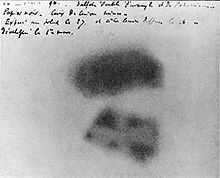អង់រី បិកកឺរ៉ែល៖ ភាពខុសគ្នារវាងកំណែនានា
បានបង្កើតទំព័រដែលផ្ដើមដោយ '''អង់ត័ន អង់រី បិកកឺរ៉ែល''' (១៥ ធ្នូ ១៨៥២ – ២៥ ស... |
|||
| បន្ទាត់ទី១៥៖ | បន្ទាត់ទី១៥៖ | ||
In 1903, he shared the [[Nobel Prize in Physics]] with [[Pierre Curie|Pierre]] and [[Marie Curie]] "in recognition of the extraordinary services he has rendered by his discovery of spontaneous radioactivity". |
In 1903, he shared the [[Nobel Prize in Physics]] with [[Pierre Curie|Pierre]] and [[Marie Curie]] "in recognition of the extraordinary services he has rendered by his discovery of spontaneous radioactivity". |
||
==ការផ្ដល់កិត្តិយស និង រង្វាន់== |
|||
==Honors and awards== |
|||
[[Image:Becquerel plate.jpg|thumb|right|រូបភាពនៃ បន្ទះចាប់រូបភាព*របស់បិកកឺរ៉ែល ដែលត្រូវបានធ្វើឱ្យស្រអាប់ដោយសារប៉ះនឹងវិទ្យុសកម្មមកពីអំបិលអ៊ុយរ៉ាញ៉ូម។ គេឃើញស្រមោល ដែករាងកាកបាទម៉ាល់តេស (Maltese Cross)ដែលដាក់នៅចន្លោះបន្ទះចាប់រូបភាព និង អំបិលអ៊ុយរ៉ាញ៉ូម យ៉ាងច្បាស់។* បន្ទះចាប់រូបភាព ជាធាតុនៃម៉ាស៊ីនថត ដែលដើរតួដូចជាហ្វ៊ីល ក្នុងម៉ាស៊ីនថតក្រោយៗមកទៀតដែរ]] |
|||
[[Image:Becquerel plate.jpg|thumb|right|Image of Becquerel's photographic plate which has been fogged by exposure to radiation from a uranium salt. The shadow of a metal [[Maltese Cross (symbol)|Maltese Cross]] placed between the plate and the uranium salt is clearly visible.]] |
|||
ក្នុងឆ្នាំ ១៩០៨, ឆ្នាំដែលគាត់ទទួលមរណភាព, បិកកឺរ៉ែល ត្រូវបានបោះឆ្នោតជាលេខាអចិន្ត្រៃយ៍របស់ [[Académie des Sciences]]។ គាត់ស្លាប់នៅអាយុ ៥៥ ឆ្នាំ នៅ [[Le Croisic]]។ |
|||
In 1908, the year of his death, Becquerel was elected Permanent Secretary of the [[Académie des Sciences]]. He died at the age of 55 in [[Le Croisic]]. |
|||
ឯកតា [[SI]] សម្រាប់វិទ្យុសកម្ម ដែលហៅថា បិកកឺរ៉ែល តាងដោយ Bq គឺដាក់តាមឈ្មោះរបស់គាត់។ នៅលើព្រះចន្ទមានមាត់ភ្នំភ្លើងមួយ មានឈ្មោះថា បិកកឺរ៉ែល ហើយនៅលើភពព្រះអង្គារ ក៏មានមាត់នំភ្លើងមួយមានឈ្មោះថា បិកកឺរ៉ែល ដែរ។ |
|||
The [[SI]] unit for radioactivity, the [[becquerel]] (Bq), is named after him. There is a crater called [[Becquerel (lunar crater)|Becquerel]] on the Moon and also a crater called [[Becquerel (Martian crater)|Becquerel]] on Mars. |
|||
ក្រៅពីទទួលបានរង្វាន់ណូបែល ក្នុងឆ្នាំ ១៩០៣ គាត់ បានទទួលរង្វាន់កិត្តិយសនានាដូចតទៅនេះ ៖ |
|||
He also received the following awards besides the [[Nobel Prize for Physics]] (1903): |
|||
*[[Rumford Medal]] (1900) |
*[[Rumford Medal]] (1900) |
||
*[[Helmholtz Medal]] (1901) |
*[[Helmholtz Medal]] (1901) |
||
កំណែនៅ ម៉ោង១៣:២៤ ថ្ងៃព្រហស្បតិ៍ ទី០១ ខែកញ្ញា ឆ្នាំ២០១១
អង់ត័ន អង់រី បិកកឺរ៉ែល (១៥ ធ្នូ ១៨៥២ – ២៥ សីហា ១៩០៨) ជារូបវិទូជាតិបារាំង ដែលបានទទួលរង្វាន់ណូបែលផ្នែករូបវិទ្យា ដោយបានរកឃើញវិទ្យុសកម្ម ជាមួយ ម៉ារី គុយរី និង ព្យែរ គុយរី នៅឆ្នាំ១៩០៣។
ជីវប្រវត្តិ
ជីវិតផ្ទាល់ខ្លួន
បិកកឺរ៉ែល ចាប់កំណើតនៅប៉ារីស ក្នុងគ្រួសារអ្នកវិទ្យាសាស្ត្រមួយ (៤ជំនាន់បើគិតទាំងកូនប្រុសរបស់គាត់ផ្ទាល់ឈ្មោះ ហ្សង់។ គាត់សិក្សាផ្នែកវិទ្យាសាស្ត្រនៅ École Polytechnique (សាលាពហុបច្ចេកទេស) និង ផ្នែកវិស្វកម្មនៅ École Nationale des Ponts et Chaussées (សាលាជាតិផ្នែកស្ពាននិងថ្នល់)។ នៅឆ្នាំ១៨៩០ គាត់បានរៀបការជាមួយ Louise Désirée Lorieux។
អាជីព
In 1892, he became the third in his family to occupy the physics chair at the Muséum National d'Histoire Naturelle. In 1894, he became chief engineer in the Department of Bridges and Highways. During the later half of his career Becquerel stayed in Clifton, Bristol while undergoing his investigations into the phosphorescence of uranium salts which was one of his most renowned discoveries.
In 1896, while investigating phosphorescence in uranium salts, Becquerel accidentally discovered radioactivity. Investigating the work of Wilhelm Conrad Röntgen, Becquerel wrapped a fluorescent substance, potassium uranyl sulfate, in photographic plates and black material in preparation for an experiment requiring bright sunlight. However, prior to actually performing the experiment, Becquerel found that the photographic plates were already exposed, showing the image of the substance. This discovery led Becquerel to investigate the spontaneous emission of nuclear radiation.
Describing his method to the French Academy of Sciences on 24 January 1896, he said:
One wraps a Lumière photographic plate with a bromide emulsion in two sheets of very thick black paper, such that the plate does not become clouded upon being exposed to the sun for a day. One places on the sheet of paper, on the outside, a slab of the phosphorescent substance, and one exposes the whole to the sun for several hours. When one then develops the photographic plate, one recognizes that the silhouette of the phosphorescent substance appears in black on the negative. If one places between the phosphorescent substance and the paper a piece of money or a metal screen pierced with a cut-out design, one sees the image of these objects appear on the negative. … One must conclude from these experiments that the phosphorescent substance in question emits rays which pass through the opaque paper and reduces silver salts.[១][២]
In 1903, he shared the Nobel Prize in Physics with Pierre and Marie Curie "in recognition of the extraordinary services he has rendered by his discovery of spontaneous radioactivity".
ការផ្ដល់កិត្តិយស និង រង្វាន់

ក្នុងឆ្នាំ ១៩០៨, ឆ្នាំដែលគាត់ទទួលមរណភាព, បិកកឺរ៉ែល ត្រូវបានបោះឆ្នោតជាលេខាអចិន្ត្រៃយ៍របស់ Académie des Sciences។ គាត់ស្លាប់នៅអាយុ ៥៥ ឆ្នាំ នៅ Le Croisic។
ឯកតា SI សម្រាប់វិទ្យុសកម្ម ដែលហៅថា បិកកឺរ៉ែល តាងដោយ Bq គឺដាក់តាមឈ្មោះរបស់គាត់។ នៅលើព្រះចន្ទមានមាត់ភ្នំភ្លើងមួយ មានឈ្មោះថា បិកកឺរ៉ែល ហើយនៅលើភពព្រះអង្គារ ក៏មានមាត់នំភ្លើងមួយមានឈ្មោះថា បិកកឺរ៉ែល ដែរ។
ក្រៅពីទទួលបានរង្វាន់ណូបែល ក្នុងឆ្នាំ ១៩០៣ គាត់ បានទទួលរង្វាន់កិត្តិយសនានាដូចតទៅនេះ ៖
- Rumford Medal (1900)
- Helmholtz Medal (1901)
- Barnard Medal (1905)
See also
- Antoine César Becquerel (his grandfather)
- A. E. Becquerel (his father)
- Jean Becquerel (his son)
References
- ↑ Henri Becquerel (1896). "Sur les radiations émises par phosphorescence". Comptes Rendus 122: 420–421.
- ↑ Comptes Rendus 122, 420 (1896), translated by Carmen Giunta. Accessed 10 September 2006.
External links
- Henri Becquerel - Biography
- Becquerel short biography and the use of his name as a unit of measure in the SI
- Annotated bibliography for Henri Becquerel from the Alsos Digital Library for Nuclear Issues
- Henri Becquerel, SI-derived unit of radioactivity
| ||||||||||||||||||
